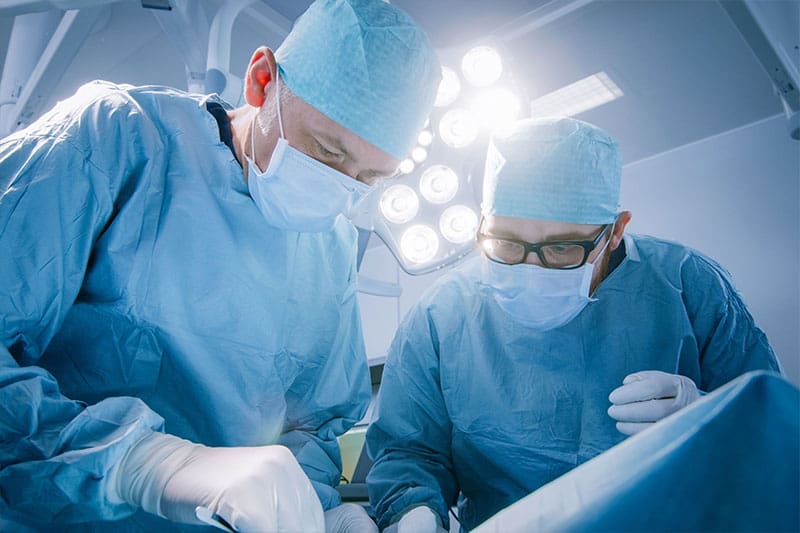Our client, a retired man in his mid-sixties, underwent a laparoscopic cholecystectomy (“lap chole”) – a surgery to remove his gallbladder. During the surgery is where the medical malpractice occurred, the surgeon severed or clipped main blood supply vessels to our client’s liver. He was transferred to another hospital and another surgeon performed an exploratory laparotomy. The diagnosis was: Massive liver necrosis status post hepatic artery and portal vein injury during laparoscopic cholecystectomy. Basically, there was lack of blood flow to the liver which caused it to die. He required an emergency liver transplant. If he did not have the liver transplant, he would have died. He currently lives with his transplanted liver, and all the life changes that go with that.
Facts
Our client began to experience severe abdominal pain. His wife took him to the emergency room. He was worked up in the emergency room and it became clear he was suffering from cholecystitis, or inflammation/infection of his gall bladder, likely due to gall stones. Our client provided a history of a previous surgery, laparoscopic Nissen procedure, to address gastroesophageal reflux. Such a surgery could give rise to adhesion formation in and around the area of the gall bladder and the defendant general surgeon was aware of this preoperatively.
During the lap chole, the defendant doctor noted that he encountered extensive adhesions upon entering the peritoneal space; commenting that he took over an hour and a half to gain the necessary exposure and to address significant bleeding problems. What was clear, though, is that the doctor was operating blind and had two choices to safely address the surgery: convert from a laparoscopic to an open procedure, thereby gaining a clearer view of the anatomy; or simply stopping the procedure and returning to surgery with assistance. The defendant doctor chose neither. Rather he continued and indiscriminately cut vital vessels supplying blood to the liver.
The damage that the defendant doctor perpetrated is as follows: he cut the left portal vein (the portal vein … even though it is a vein … brings oxygenated blood to the liver); he clipped closed and cut the hepatic artery; and he cut the common bile duct. As plaintiff’s expert general surgeon, would have testified at trial, these surgical deviations amount to a “never occurrence.” The defendant doctor readily admits that when performing a lap chole, the proper surgery does not contemplate cutting the portal vein, does not contemplate cutting the hepatic artery; and does not contemplate cutting the common bile duct. Nonetheless, he gave the opinion that a surgeon can cause all of this damage and still be in compliance with accepted standards of care. In short, the defendant argued that he can damage these vital structures, believing he was cutting another vessel or duct.
Review of the defendant doctor’s operative report revealed that he had no idea that he damaged these vital structures. He noted in his operative report that he cut and clipped the cystic artery and cut and clipped the cystic duct … the appropriate vessel and the appropriate duct. When our client was emergently transferred to a different hospital the evening after the lap chole, he underwent an immediate exploratory laparotomy performed by another surgeon, who described the damage caused by the defendant doctor and, importantly, his findings were nothing like what the defendant doctor described in his operative report.
It was our position that the defendant doctor’s argument – that this type of damage is a “recognized risk” or an “accepted complication” of a lap chole would have fallen on deaf ears from the jury at trial. This is particularly so when the physician performing the lap chole had no idea he even damaged the structures. It is one thing for a physician to say “I was being reasonably careful but because of a certain circumstance I cut an artery or vein that I should not have.” But that was not the case here. The defendant doctor had no idea he was cutting critical vessels and the common bile duct; he thought he was cutting all the right structures.
The plaintiff’s expert general surgeon would have testified that not only did the defendant doctor not outline any of the damage that he caused, but the defendant doctor also described two different lap chole procedures: a complete lap chole and a partial lap chole, where the posterior wall of the gall bladder remains attached to the liver. Pathology states a complete gall bladder was provided to it. While plaintiffs are aware of the standard argument that defendants make when plaintiff complains about poor dictation or incomplete noting, here it is quite different. Given defendant doctor’s operative report and testimony, and given the findings and testimony of the subsequent surgeon, and the findings by the surgical pathologist, there are two reasonable arguments for plaintiffs to make … neither of which would have gone well for the defendant surgeon:
- Defendant doctor was indiscriminately cutting vital connections that should not be damaged during this surgery and he did not know he was doing it; and, further, he did not know what procedure he did;
- Defendant doctor realized what he had done in whole or in part and fabricated his operative report to cover his mistakes.
Two of the plaintiff’s experts, a general surgeon and transplant surgeon, were highly critical of the conduct of the defendant doctor. Each physician was willing to testify that there is no justification for what he did during surgery; neither have ever seen this happen in their careers. Our general surgeon would have testified that since cholecystectomies have been performed in America (millions) there have only been 15 instances of a similar complications being reported in the literature. Both plaintiff’s experts would have testified that the defendant’s surgery caused the death of our client’s liver which resulted in the need for the liver transplant.
The plaintiff’s expert general surgeon was also critical of the defendant doctor for failing to timely recognize what he did after the surgery. He ordered liver enzyme testing on our client within hours after the surgery. According to plaintiff’s expert, these are not standard tests following a lap chole. The expert would have testified that the defendant doctor knew or should have known during surgery of his critical errors and should have addressed it at that point. Even after surgery, by his conduct in ordering the liver enzymes, the defendant doctor was aware of trouble and when the enzymes returned highly elevated, indicative of liver damage, he did not timely respond by taking the plaintiff back to surgery or referring him to a tertiary facility immediately. Rather he ran more tests which simply confirmed that the liver was dying. Plaintiff’s expert general surgeon would have testified that the defendant doctor’s post-operative conduct removed any chance of salvaging the liver.
Damages
Our client has undergone life-saving surgeries and has had several early complications following his liver transplant. Because of the liver transplant, he will require anti-rejection medication for the remainder of his life. He had an early organ rejection incident that the liver transplant team was able to address and save the transplanted liver. Nonetheless, the transplanted liver was damaged and will be more fragile for the remainder of its existence.
The anti-rejection medications create the risk for primary cancers to develop in our client. He is currently diagnosed as suffering from Large Granular Lymphocytic leukemia which is currently being monitored. Because of immunosuppression, he is at greater risk for viral and bacterial infection. He has been diagnosed with circulating cytomegalovirus (CMV) in his bloodstream which is also being monitored.
Our client undergoes monthly blood tests and has several doctor visits per year for routine follow up visits and monitoring. He has been an in-patient at the hospital on at least five occasions to deal with surgical and systemic problems related to his liver transplant.
Emotionally, the toll on our client and his wife has been extreme. They make the best of it, but always are aware that circumstances can change in an instant. The medical bills incurred by our client were more than one million dollars.
Conclusion
This case was defended aggressively by lawyers for the defendant doctor and the hospital he worked at for nearly four years. Eventually, the lawyers for the defendants asked for a mediation to which we agreed. The case was mediated by a retired judge with significant experience in presiding over medical malpractice trials. After a full day mediation, the case resolved for $3,250,000.00.












